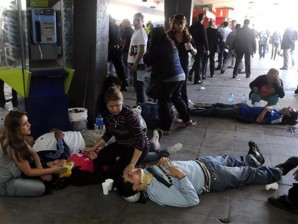
Injured passengers from a commuter train wait to be carried away after a collision in Buenos Aires, Argentina, Wednesday Feb. 22, 2012. A packed train slammed into the end of the line in Buenos Aires' busy Once station Wednesday, killing dozens and injuring hundreds, according to police. (AP Photo/Leonardo Zavattaro,Telam)
BUENOS AIRES—Desperate families were searching for loved ones Thursday after a massive train crash in Buenos Aires killed 50 people, injured nearly 700 and left dozens trapped for hours in the wreckage.
Rescuers spent much of the day prying people from the wreckage after the packed train slammed into a wall at a major railway terminus Wednesday morning, sending cars crashing into each other and crushing the passengers inside.
“The train was full and the impact was tremendous,” a passenger identified only as Ezequiel told local television, adding that medics at the scene appeared overwhelmed by the scale of the disaster.
Officials late Wednesday raised the death toll to 50, including one child. Civil defense officials earlier said that at least 675 people had been hurt in the crash, 200 of them seriously.
Families of missing passengers desperately searched hospitals, the morgue and a public cemetery where dozens of bodies were taken.
Authorities handed out lists of hundreds of the injured, but the identities of many of the deceased and wounded remained unknown.
“I was in five hospitals and I couldn’t find my wife,” said a man who gave his name as Jose and said his pregnant wife had been in one of the first cars.
“They told us there are people being operated on and they don’t know who they are. There’s no way to know until they come out of surgery,” said Luisa, looking for her 24-year-old son.
TV channels broadcast photographs of missing people as social networks filled with messages from people searching for information.
Witnesses said the train’s brakes failed as it was arriving at the Once station on the western outskirts of Argentina’s capital.
Survivors described a scene of panic, with Medevac helicopters and ambulances racing in and out of the station to ferry the wounded to hospitals.
“There were people who were crushed and shouting desperately. I saw bodies and blood all over the place,” said passenger Alejandro Velazquez.
Firefighters and rescue workers had to break through skylights in the train’s roofs to reach dozens of people who were trapped in the twisted wreckage of the first and second carriages.
The government called for two days of mourning and suspended Carnival celebrations, including a massive parade planned in Buenos Aires on Friday.
Argentine President Cristina Kirchner suspended a news conference on the dispute with Britain over the Falkland Islands following news of the crash.
Condolences from the British minister of state for Latin America, Jeremy Browne, were among numerous foreign sympathy messages sent to Argentina.
Transport Secretary Juan Pablo Schiavi said the train entered the station at a speed of 20 kilometers (12 miles) an hour and failed to stop, crashing into a retaining wall in what he called “a very serious accident.”
The train’s driver was injured but rescue workers pried him loose from the wreckage of his cabin. He was 28 years old and had an excellent record, according to Schiavi.
The Sarmiento rail line, owned by private company TBA, links the center of Buenos Aires to a densely populated suburb 70 kilometers (44 miles) to the west of the city. It uses rolling stock made in Japan and acquired in the 1960s.
TBA said it did not know the cause of the crash and would bring “all information and videos to the courts.”
Schiavi said officials had a recording of conversations between the driver and the person in charge of the line.
As a probe got under way, rail workers complained about a lack of investment following the privatization of the rail network in the 1990s.
Unionist Roberto Nunez, speaking on Radio del Plata, cited “irregularities, deficiencies and a situation limited to the provision of services.”
The toll from Wednesday’s crash surpassed the city’s last major rail disaster just five months ago, when two trains and a bus collided during rush hour, killing 11 people and injuring more than 200.
The region’s transit system has been plagued with serious accidents in recent years.
In March 2008, 18 people were killed and 47 injured when a bus was hit by a train in Dolores, 212 kilometers south of Buenos Aires.
Argentina’s deadliest train tragedy was in 1970, an accident that killed 236 people in northern Buenos Aires.